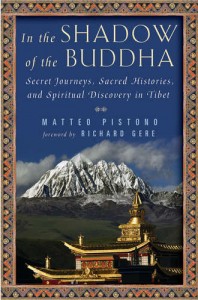Matteo Pistono: A few thoughts on The Tibetan Book of Living and Dying
Matteo Pistono, author of a new book called In the Shadow of the Buddha writes: “I first read The Tibetan Book of Living and Dying in a library at Kopan monastery in Kathmandu. It was in 1994, a year before I met Sogyal Rinpoche. I literally could not put the already dog-eared book down and read it in a single day. The next days as I walked around Kathmandu, I repeatedly “saw” the enlightened potential—the Buddha nature—in taxi drivers, street sweepers, and shop owners—and in myself. The book changed me, forever.
What is the source of the wisdom in that book, I later asked myself? The transformational power it had on me was undeniable. I wanted to know from where its transformational power emanated.
Of course having the blessed words of Sogyal Rinpoche and his enlightened intent helps significantly.
Yet, we know that any “result” is comprised of a complex matrix of conditions and causes. It is indeed impossible to name any single “cause” for any particular “result.” In trying to understand the root of The Tibetan Book of Living and Dying’s power, I retrace Sogyal Rinpoche’s spiritual heritage. I search for clues in the causal chain that render the on-going “effects” of The Tibetan Book of Living and Dying that we see in readers today, and I see in my own life. In this search, I repeatedly return to the life of Sogyal Rinpoche’s previous incarnation, Nanam Dorje Dudjom. Allow me to explain—there is a bit of history.
Dorje Dudjom of the Nanam clan was the minister of state for King Trisong Detsen in the 8th century, just after Tibet’s power had reached its apex. The king’s initial attempts to spread Buddhism throughout Tibet by creating a monastic order and building a monastery were thwarted. Local shamans and magicians directed spirits and demons to destroy at night any construction that was accomplished during the day. The shamans also caused a series of disasters, including drought and floods that brought famine and diseases. The elderly Bengali monk Shantarakshita, who was in Tibet on imperial patronage at the time, advised the king to search in India for the Buddhist master known as Padmasambhava to come to the sovereign’s aid. If the depictions we have today of Padmasambhava are accurate—heavyset, furrowed brow, and a slightly wrathful grin welcoming challenges—then the king had found just the right master to accomplish the task. While the historical Buddha is known for his compassionate teachings on peacefully abiding, Padmasambhava was more of a tough-love teacher who offered powerful methods for removing obstacles to enlightenment.
King Trisong Detsen dispatched a group of envoys led by Dorje Dudjom with offerings across the Himalayas to invite Padmasambhava. Padmasambhava soon arrived in Tibet and proceeded to establish Buddhism throughout the country. Tibet, as a political entity, with the unifying social force of a shared religion, was established. Tibet owes its spiritual and political foundation to the father of Tibetan Buddhism, Padmasambhava, which is why Tibetans still refer to him as the Second Buddha.
The Dalai Lama has said of Padmasambhava, “It was because of his overarching power and strength that the Buddhadharma was really established in Tibet, and then developed so that all the teachings of the Buddha, including the Mantrayana were preserved as a living tradition, and have continued down to the present day.”
Let’s think now what was one of the primary causes for Padmasambhava arriving in the Land of Snows to spread the teachings of the Buddha? It was undoubtedly the effort of the saint Dorje Dudjom who invited and escorted Padmasambhava to Tibet. Imagine the positive karmic seeds that Dorje Dudjom planted from that singular event? And what happens when those seeds blossom? As we know, results manifest larger than the cause—just look at wildfire on a mountain side and consider the size of a spark, or at a California Redwood and remember the seed from which it grew.
I believe the positive karmic seeds that Dorje Dudjom accumulated in the 8th century by inviting and serving Padmasambhava are ripening today in Sogyal Rinpoche’s vast activities. Except for the Dalai Lama, no other lama has connected to more Westerners than Sogyal Rinpoche has through the book The Tibetan Book of Living and Dying. And in China, the hundreds of thousands of copies sold of The Tibetan Book of Living and Dying in Mandarin, including multiple pirated editions I have seen on bookshelves including in the Potala Palace’s bookstore in Lhasa, is evidence of its continuing impact. And, we must not forget the magnanimous accomplishments in Tibet and China of another of Dorje Dudjom’s incarnations, the late Khenpo Jikme Phuntosk.
So the transformational power in Dorje Dudjom’s enlightened intent, and Sogyal Rinpoche’s teachings including The Tibetan Book of Living and Dying, I have come to the conclusion emanate from the same source. It come from the profound truth that all beings and myself are Buddhas to-be…we just have to get over ourselves, let go of our hang-ups, to recognize it!
Dorje Dudjom may have changed bodies over successive incarnations up to the present, but the motivation and the vastness of his vision remains the same—to create the most generous and auspicious conditions for as many of us as possible to find the path to spiritual liberation and lasting happiness. And the Tibetan Book of Living and Dying is unquestionably a manifestation of that vision. I bow down in gratitude to Sogyal Rinpoche for writing it.”
Matteo Pistono is a writer, practitioner of Tibetan Buddhism, and author of In the Shadow of the Buddha: Secret Journeys, Sacred Histories, and Spiritual Discovery in Tibet. Pistono’s images and writings about Tibetan and Himalayan cultural, political, and spiritual landscapes have appeared in The Washington Post, BBC’s In-Pictures, Men’s Journal, Kyoto Journal, and HIMAL South Asia.

